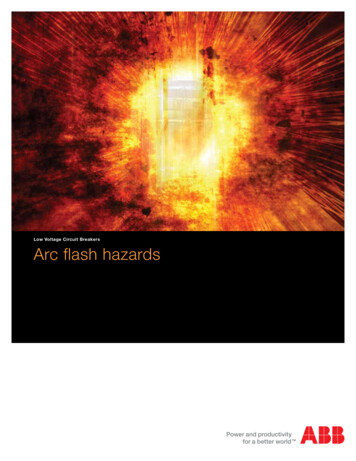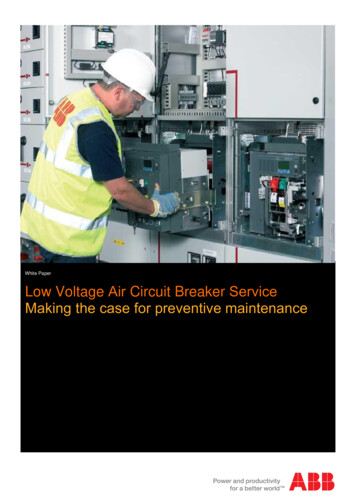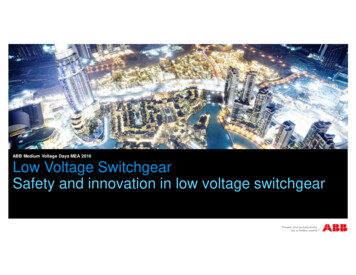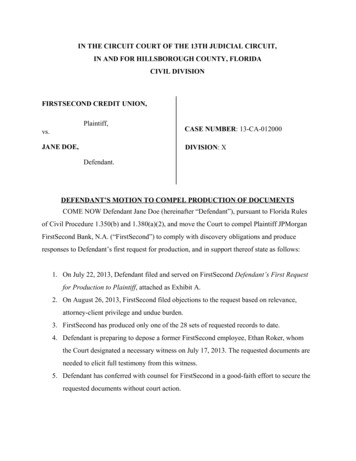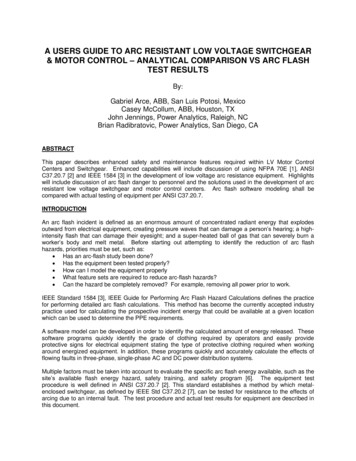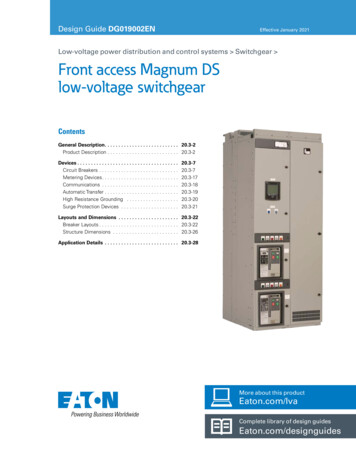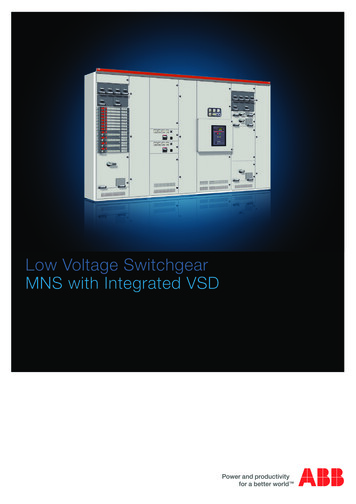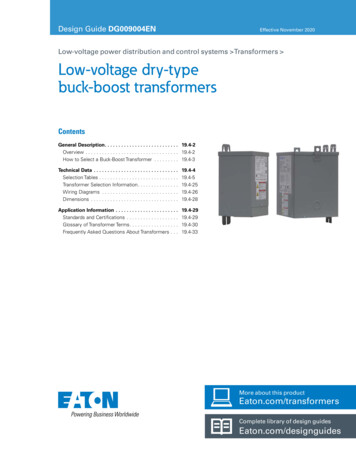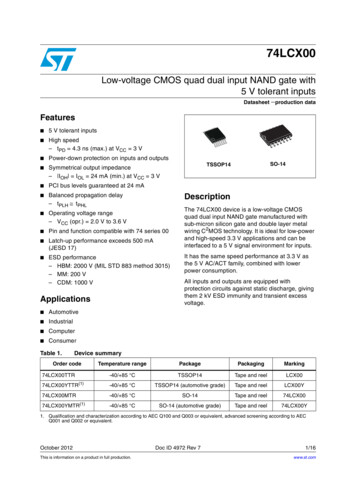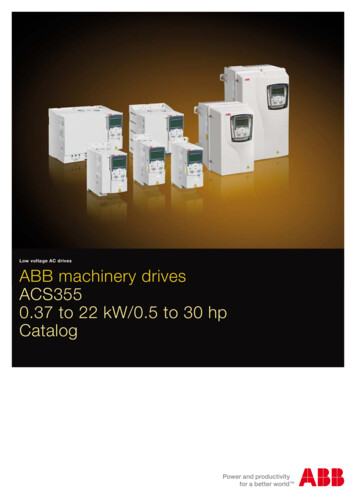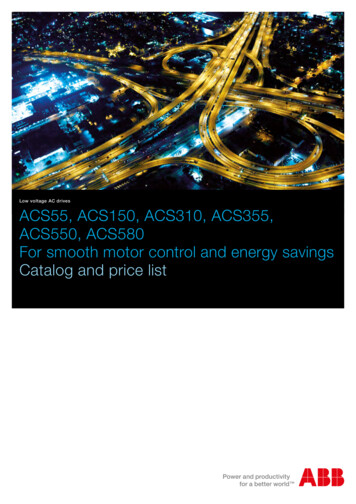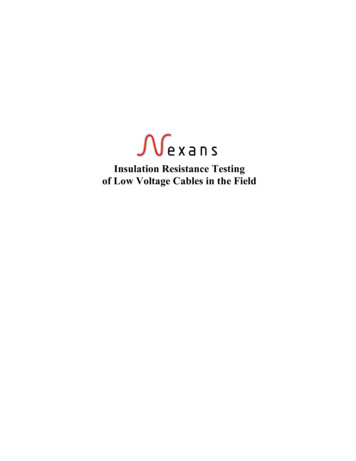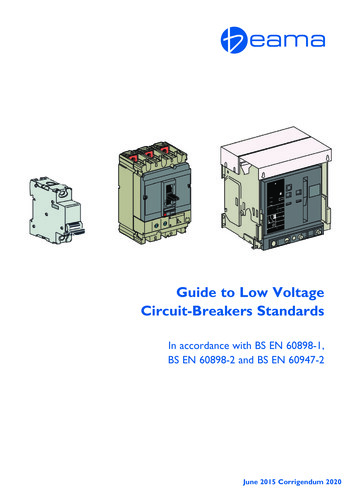
Transcription
Guide to Low VoltageCircuit-Breakers StandardsIn accordance with BS EN 60898-1,BS EN 60898-2 and BS EN 60947-2June 2015 Corrigendum 2020
BEAMA Guide to Low Voltage Circuit-breakers Standards in accordancewith BS EN 60898-1, BS EN 60898-2 and BS EN 60947-2Companies involved in the preparation of this GuideBEAMA would like to thank IEC and BSI for allowing reference to their standards.
ContentsINTRODUCTION4ABBREVIATIONS AND DEFINITIONS51. Standards61.1. Low voltage circuit-breaker standards1.2. United Kingdom Standards2. Types of Circuit-Breaker2.1. Miniature circuit-breakers2.2. Moulded Case circuit-breakers2.3. Air circuit-breakers67999103. Low voltage circuit-breakers for use in household and similar installations 113.1 History of the development of BS EN 608983.2. BS EN 60898 Characteristics3.3. BS EN 60898 Time/Current Characteristics3.4. BS EN 60898 Rated values3.5 Installation Factors4. Low voltage circuit-breakers for use in industrial and similar installations4.1 History of the development of BS EN 60947-24.2. BS EN 60947-2 Characteristics4.3 BS EN 60947-2 Rated Values4.4 Installation Factors4.5 Determination of maximum earth Loop impedance (Zs)4.6. Harmonic currents5. Technical And Application Data – all Low Voltage Circuit-breakersto BS EN 60898-1, BS EN 60898-2 and BS EN 60947-25.1. Circuit-breaker substitution in assemblies5.2. Functional switching with Circuit-breakers5.3. Coordination of Low-voltage Switchgear and Controlgear assemblies withconductors operating at a temperature exceeding 70 C e.g. XLPE5.4. Overcurrent coordination of devices from different manufacturersCompanies involved in the preparation of this Guide111112131721212223272728303030313134
BEAMA Guide to Low Voltage Circuit-Breakers in accordancewith BS EN 60898-1, BS EN 60898-2 and BS EN 60947-2IntroductionThis guide is intended as a practical guide for designers, specifiers and installers to enable them tospecify low voltage circuit-breakers in accordance with BS EN 60898-1, BS EN 60898-2 andBS EN 60947-2.This guide should be read in conjunction with these standards as it provides additional explanationon each section.This guide has been produced by BEAMA’s Industrial & Single Phase Product Group, and explains thecharacteristics of low voltage circuit-breakers for use in industrial and household and similarinstallations, which fall within the wide scope of BEAMA’s Industrial & Single Phase Product Group.BEAMA’s Industrial & Single Phase Product Group comprises major UK manufacturing companies inthis field and has its own officers, technical and other committees, all operating under the guidanceand authority of BEAMA, supported by specialist central services for guidance on European SingleMarket, Quality Assurance, Legal and Health & Safety matters.Active participation in the work of numerous national, international and regional standardscommittees has provided the background and support to ensure safety and performance for thedesign, development and manufacture of its members’ products. The result is quality equipment ofthe highest standard throughout each group of the association.BEAMA’s Industrial & Single Phase Product Group is part of BEAMA’s Installation sector, well knownfor its authoritative industry Guides. Details of other BEAMA Installation Sector guides can be foundon the BEAMA website.www.beama.org.ukBEAMA is the long established and respected trade association for the electrotechnical sector.The association has a strong track record in the development and implementation of standards,safety and product performance for the benefit of manufacturers and their customers.DISCLAIMERThis publication is subject to the copyright of BEAMA Ltd. While the information herein has beencompiled in good faith, no warranty is given or should be implied for its use and BEAMA herebydisclaims any liability that may arise from its use to the fullest extent permitted under applicable law. BEAMA Ltd 2014Copyright and all other intellectual property rights in this document are the property of BEAMA Ltd.Any party wishing to copy, reproduce or transmit this document or the information contained withinit in any form, whether paper, electronic or otherwise should contact BEAMA Ltd to seek permissionto do so.4Guide to Low-Voltage Circuit-Breakers Standards
Abbreviations and DefinitionsACBAir circuit-breaker. A circuit-breaker in which the contacts open and close in air atatmospheric pressure. The term is conventionally applied to high current rated circuitbreakers ( 800A). Also referred to as ‘power-breakers’.CENELECThe body responsible for standards in affiliated countries in Europe.IECInternational Electrotechnical Commission – the body responsible for standards in membercountries world-wide.LVDLow-voltage Directive – European directive giving the essential safety requirements for lowvoltage equipment.MCBMiniature circuit-breaker.MCCBMoulded Case circuit-breaker.r.m.s.Effective value of an alternating current (heating effect). Mathematically derived from thesquare root of the mean squares of the instantaneous values.RCBOResidual-current circuit-breaker incorporating overcurrent protection.SCPDShort-circuit protective device intended to protect a circuit or parts of a circuit againstshort-circuit currents by interrupting them.Guide to Low-Voltage Circuit-Breakers Standards5
1. Standards1.1 Low Voltage Circuit-Breaker Standards1.1.1. HarmonisationIn an ideal world, the compatibility of manufactured goods across a wide geographicalarea can remove barriers to trade and can result in an efficiency of scale due toincreased manufacturing volumes which in turn can reduce costs. In the electricalindustry, appropriate standardisation could mean common supply networks andproducts; and in low-voltage circuit-breaker applications can result in: ability to use compatible equipment;no need to adapt or modify such products;fewer limitations on the source of supply.To this end considerable progress has already been made by the national standardscommittees of over 80 nations who are co-operating to formulate world standardswhich provide a consensus of international opinion on electrical supply andharmonisation.1.1.2. World StandardsParticipating countries comprise the International Electrotechnical Commission (IEC).Most of these participating countries already have their own national standards whichmay differ from elements of the IEC Standards. However when a need forharmonisation is identified, documents produced by the IEC may, where appropriate,form the basis for future national standards.1.1.3. European StandardsWithin Europe harmonisation of electrical products is controlled by CENELEC(Comite Européenne de Normalisation Electrotechnique) which produces appropriateEuropean standards generally based on the work of the IEC, once a need has beenidentified and agreed.CENELEC is made up of over 30 national standards committees of the European Union andEFTA (European Free Trade Association). Whilst a European Standard can be a directreplica of an IEC standard, discussions within CENELEC may result in the formulation of astandard which includes commonly agreed variations.Two types of publication exist: the European Norm (prefixed EN-) and the HarmonisedDocument (prefixed HD-) where EN- qualifies the adoption of the standard by all membercountries without deviation; and HD- a document that does not have to be adopted as anational standard but no conflicting national standards must exist.6Guide to Low-Voltage Circuit-Breakers Standards
The European Norm, within its scope, covers all the relevant essential requirements as givenin Article 4 of the LVD (Low-voltage directive). This means that circuit-breakers complyingwith the standards quoted in this Guide comply with the essential requirements of the LVDand the CE mark must be applied.The numbering of an EN- or HD- indicates the presence or otherwise of an IEC Standard.The 6xxxx series indicates that a EN or HD is based on a published IEC document whilst5xxxx series indicates that the EN or HD originated in Europe and there is no publishedIEC equivalent document.1.2.United Kingdom StandardsAdoption of the European Standard (EN) within the EU is mandatory. In the UK suchstandards are further endorsed with the additional ‘BS’ prefix, for example: BS EN60898, the British Standard for circuit-breakers for overcurrent protection forhousehold and similar installations.BS EN 60898-1 (EN 60898-1, IEC 60898-1) & BS EN 60898-2 (EN 60898-2,IEC 60898-2) relate to low-voltage circuit-breakers for use in household and similarinstallations. In the UK these are traditionally known as miniature circuit-breakers or(MCB’s).HouseholdSchoolsGuide to Low-Voltage Circuit-Breakers StandardsRetailOffices7
BS EN 60947-2 (EN 60947-2, IEC 60947-2) relate to low-voltage circuit-breakers for use inindustrial and similar installations. In the UK these are traditionally known as moulded casecircuit-breakers (MCCB’s) or air circuit-breakers (ACB’s) according to the construction.Car AssemblySteel Production8PetrochemicalFood ProcessingGuide to Low-Voltage Circuit-Breakers Standards
2. Types of Circuit-breakerMCBMCCBACB2.1. Miniature Circuit-breakers(MCBs) to BS EN 60898 are suitable for operation by ordinary persons and have fixedprotection settings, generally a two position on/off operating handle and a performancerelative to the final circuits in an electrical installation. They would normally be the finalovercurrent protection measure in the electrical system, for example before sockets orlighting circuits.Typical current ratings are from 0.5 A to 125 A. Short-circuit ratings may be up to 25 kA.Performance and testing is in accordance with BS EN 60898 for domestic and similarapplications categorised by the trip characteristic types B, C & D. MCBs may also beavailable with application specific tripping characteristics.MCBs may also be rated in accordance with BS EN 60947-2 for industrial or similarapplications2.2. Moulded Case Circuit-breakers(MCCBs) may have fixed or adjustable protection settings, normally a three position toggleoperating handle giving on-off-tripped indication plus reset function, and a performance levelrelative to the incoming supply such that they can be installed at a point close to the supplytransformer.Typical current ratings are from 16 A to 1600 A though ratings up to 3,200 A are available.Short-circuit ratings may be up to 100 kA. Performance and testing is in accordance with BSEN 60947-2.Guide to Low-Voltage Circuit-Breakers Standards9
2.3. Air Circuit-breakers(ACBs) are normally used as the main incoming protection and have a spring-operatedmechanism to open and close the device often charged by an internal motor. The protectionsettings will include time delays and the devices will have a short-time withstand value to givefull discrimination under fault conditions with downstream protection devices.Typical current ratings are 630 to 6,300 A. Short-circuit ratings may be up to 150 kA.Performance and testing is in accordance with BS EN 60947-2.10Guide to Low-Voltage Circuit-Breakers Standards
3.Low Voltage Circuit-Breakers for use inHousehold and Similar Installations3.1. History of the development of 60898BS EN 60898-1, BS EN 60898-2 (EN 60898-1, EN 60898-2, IEC 60898-1 IEC 60898-2)BS 3871 Part 11965IEC 8981987BS EN 608981991EN 608981991BS EN 60898-12003BS EN 60898-22001It can be seen from the diagram above that up to 1987 no IEC Standard existed for miniaturecircuit-breakers that, in the UK, had been manufactured since 1965 to BS 3871, under thetitle ‘Miniature Air Circuit-breakers for a.c. circuits.’The introduction in 1987 of IEC 898, under the title ‘Circuit-breakers for OvercurrentProtection for Household and Similar Installations’, formed the basis for acceptance of theEuropean Standard EN 60898; which was published in the UK in 1991, as BS EN 60898. BS3871 Part 1 was withdrawn on the 1st July 1994.Products that complied with BS 3871 Part 1 before 1st July 1994, as shown by themanufacturer, were allowed to apply for production until 30th June 1999. Since this date allproducts should comply with BS EN 60898.BS EN 60898 was further developed into parts 1 and 2. BS EN 60898-1 gives therequirements for circuit-breakers rated for a.c. only and BS EN 60898-2 gives therequirements for circuit-breakers rated for both a.c and d.c.3.2. BS EN 60898 Characteristics3.2.1. Preferred values of currentThe preferred values are 6, 8, 10, 13, 16, 20, 25, 32, 40, 50, 63, 80, 100 and 125 A.3.2.2. IsolationCircuit-breakers conforming to BS EN 60898 are suitable for isolation. However, miniaturecircuit-Breakers (MCBs) manufactured to earlier standards (such as BS 3871) are unlikely tobe suitable for isolation.Guide to Low-Voltage Circuit-Breakers Standards11
3.3 BS EN 60898 Time/Current Characteristics3.3.1. Instantaneous Trip Setting Type to BS EN 6089860898-1onlyTime (seconds)BInTripTypeRange ofinstantaneousTrip ( 0.1 s)3xLoad TypeC5xD10x20xCurrent (x In)Typical Load(see manufacturer's data for application)BS EN 60898-1 RangeB3 to 5 InResistiveHeaters, showers, cookers, socket outlets.C5 to 10 InInductiveMotors, general lighting circuits, power supplies.D10 to 20 InHigh InductiveTransformers, motors, discharge lighting circuits, computers.Note: There is no Type A instantaneous tripping characteristic to avoid confusion with the A abbreviation for amperes.BS EN 60898-2 RangeB3 to 5 In (a.c)4 to 7 In (d.c)ResistiveHeaters, showers, cookers, socket outlets.Rail, photovoltaic.C5 to 10 In (a.c)7 to 15 In (d.c)InductiveMotors, general lighting circuits, power supplies.Rail, photovoltaic.BS 3871 Range (Superseded)12.7 to 4 InResistiveDomestic, Heaters, Showers, Cookers, general socket outlets24 to 7 InResistive/InductiveSmall inductive switching loads, lighting and domestic circuits37 to 10 InInductiveMotors, general lighting circuits, power supplies.410 to 50 InHigh InductiveTransformers, motors, discharg
to BS EN 60898-1, BS EN 60898-2 and BS EN 60947-2 30 5.1. Circuit-breaker substitution in assemblies 30 5.2.Functional switching with Circuit-breakers 30
